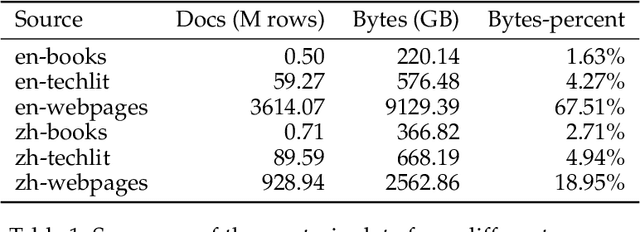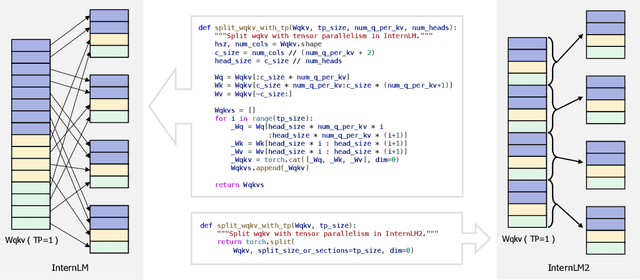Qi Fan
CUDA-LLM: LLMs Can Write Efficient CUDA Kernels
Jun 10, 2025Abstract:Large Language Models (LLMs) have demonstrated strong capabilities in general-purpose code generation. However, generating the code which is deeply hardware-specific, architecture-aware, and performance-critical, especially for massively parallel GPUs, remains a complex challenge. In this work, we explore the use of LLMs for the automated generation and optimization of CUDA programs, with the goal of producing high-performance GPU kernels that fully exploit the underlying hardware. To address this challenge, we propose a novel framework called \textbf{Feature Search and Reinforcement (FSR)}. FSR jointly optimizes compilation and functional correctness, as well as the runtime performance, which are validated through extensive and diverse test cases, and measured by actual kernel execution latency on the target GPU, respectively. This approach enables LLMs not only to generate syntactically and semantically correct CUDA code but also to iteratively refine it for efficiency, tailored to the characteristics of the GPU architecture. We evaluate FSR on representative CUDA kernels, covering AI workloads and computational intensive algorithms. Our results show that LLMs augmented with FSR consistently guarantee correctness rates. Meanwhile, the automatically generated kernels can outperform general human-written code by a factor of up to 179$\times$ in execution speeds. These findings highlight the potential of combining LLMs with performance reinforcement to automate GPU programming for hardware-specific, architecture-sensitive, and performance-critical applications.
Interpretable and Reliable Detection of AI-Generated Images via Grounded Reasoning in MLLMs
Jun 08, 2025Abstract:The rapid advancement of image generation technologies intensifies the demand for interpretable and robust detection methods. Although existing approaches often attain high accuracy, they typically operate as black boxes without providing human-understandable justifications. Multi-modal Large Language Models (MLLMs), while not originally intended for forgery detection, exhibit strong analytical and reasoning capabilities. When properly fine-tuned, they can effectively identify AI-generated images and offer meaningful explanations. However, existing MLLMs still struggle with hallucination and often fail to align their visual interpretations with actual image content and human reasoning. To bridge this gap, we construct a dataset of AI-generated images annotated with bounding boxes and descriptive captions that highlight synthesis artifacts, establishing a foundation for human-aligned visual-textual grounded reasoning. We then finetune MLLMs through a multi-stage optimization strategy that progressively balances the objectives of accurate detection, visual localization, and coherent textual explanation. The resulting model achieves superior performance in both detecting AI-generated images and localizing visual flaws, significantly outperforming baseline methods.
Adapting In-Domain Few-Shot Segmentation to New Domains without Retraining
Apr 30, 2025Abstract:Cross-domain few-shot segmentation (CD-FSS) aims to segment objects of novel classes in new domains, which is often challenging due to the diverse characteristics of target domains and the limited availability of support data. Most CD-FSS methods redesign and retrain in-domain FSS models using various domain-generalization techniques, which are effective but costly to train. To address these issues, we propose adapting informative model structures of the well-trained FSS model for target domains by learning domain characteristics from few-shot labeled support samples during inference, thereby eliminating the need for retraining. Specifically, we first adaptively identify domain-specific model structures by measuring parameter importance using a novel structure Fisher score in a data-dependent manner. Then, we progressively train the selected informative model structures with hierarchically constructed training samples, progressing from fewer to more support shots. The resulting Informative Structure Adaptation (ISA) method effectively addresses domain shifts and equips existing well-trained in-domain FSS models with flexible adaptation capabilities for new domains, eliminating the need to redesign or retrain CD-FSS models on base data. Extensive experiments validate the effectiveness of our method, demonstrating superior performance across multiple CD-FSS benchmarks.
Domain-Rectifying Adapter for Cross-Domain Few-Shot Segmentation
Apr 16, 2024



Abstract:Few-shot semantic segmentation (FSS) has achieved great success on segmenting objects of novel classes, supported by only a few annotated samples. However, existing FSS methods often underperform in the presence of domain shifts, especially when encountering new domain styles that are unseen during training. It is suboptimal to directly adapt or generalize the entire model to new domains in the few-shot scenario. Instead, our key idea is to adapt a small adapter for rectifying diverse target domain styles to the source domain. Consequently, the rectified target domain features can fittingly benefit from the well-optimized source domain segmentation model, which is intently trained on sufficient source domain data. Training domain-rectifying adapter requires sufficiently diverse target domains. We thus propose a novel local-global style perturbation method to simulate diverse potential target domains by perturbating the feature channel statistics of the individual images and collective statistics of the entire source domain, respectively. Additionally, we propose a cyclic domain alignment module to facilitate the adapter effectively rectifying domains using a reverse domain rectification supervision. The adapter is trained to rectify the image features from diverse synthesized target domains to align with the source domain. During testing on target domains, we start by rectifying the image features and then conduct few-shot segmentation on the domain-rectified features. Extensive experiments demonstrate the effectiveness of our method, achieving promising results on cross-domain few-shot semantic segmentation tasks. Our code is available at https://github.com/Matt-Su/DR-Adapter.
ONNXPruner: ONNX-Based General Model Pruning Adapter
Apr 10, 2024Abstract:Recent advancements in model pruning have focused on developing new algorithms and improving upon benchmarks. However, the practical application of these algorithms across various models and platforms remains a significant challenge. To address this challenge, we propose ONNXPruner, a versatile pruning adapter designed for the ONNX format models. ONNXPruner streamlines the adaptation process across diverse deep learning frameworks and hardware platforms. A novel aspect of ONNXPruner is its use of node association trees, which automatically adapt to various model architectures. These trees clarify the structural relationships between nodes, guiding the pruning process, particularly highlighting the impact on interconnected nodes. Furthermore, we introduce a tree-level evaluation method. By leveraging node association trees, this method allows for a comprehensive analysis beyond traditional single-node evaluations, enhancing pruning performance without the need for extra operations. Experiments across multiple models and datasets confirm ONNXPruner's strong adaptability and increased efficacy. Our work aims to advance the practical application of model pruning.
InternLM2 Technical Report
Mar 26, 2024



Abstract:The evolution of Large Language Models (LLMs) like ChatGPT and GPT-4 has sparked discussions on the advent of Artificial General Intelligence (AGI). However, replicating such advancements in open-source models has been challenging. This paper introduces InternLM2, an open-source LLM that outperforms its predecessors in comprehensive evaluations across 6 dimensions and 30 benchmarks, long-context modeling, and open-ended subjective evaluations through innovative pre-training and optimization techniques. The pre-training process of InternLM2 is meticulously detailed, highlighting the preparation of diverse data types including text, code, and long-context data. InternLM2 efficiently captures long-term dependencies, initially trained on 4k tokens before advancing to 32k tokens in pre-training and fine-tuning stages, exhibiting remarkable performance on the 200k ``Needle-in-a-Haystack" test. InternLM2 is further aligned using Supervised Fine-Tuning (SFT) and a novel Conditional Online Reinforcement Learning from Human Feedback (COOL RLHF) strategy that addresses conflicting human preferences and reward hacking. By releasing InternLM2 models in different training stages and model sizes, we provide the community with insights into the model's evolution.
DARNet: Bridging Domain Gaps in Cross-Domain Few-Shot Segmentation with Dynamic Adaptation
Dec 08, 2023Abstract:Few-shot segmentation (FSS) aims to segment novel classes in a query image by using only a small number of supporting images from base classes. However, in cross-domain few-shot segmentation (CD-FSS), leveraging features from label-rich domains for resource-constrained domains poses challenges due to domain discrepancies. This work presents a Dynamically Adaptive Refine (DARNet) method that aims to balance generalization and specificity for CD-FSS. Our method includes the Channel Statistics Disruption (CSD) strategy, which perturbs feature channel statistics in the source domain, bolstering generalization to unknown target domains. Moreover, recognizing the variability across target domains, an Adaptive Refine Self-Matching (ARSM) method is also proposed to adjust the matching threshold and dynamically refine the prediction result with the self-matching method, enhancing accuracy. We also present a Test-Time Adaptation (TTA) method to refine the model's adaptability to diverse feature distributions. Our approach demonstrates superior performance against state-of-the-art methods in CD-FSS tasks.
Stable Segment Anything Model
Dec 05, 2023Abstract:The Segment Anything Model (SAM) achieves remarkable promptable segmentation given high-quality prompts which, however, often require good skills to specify. To make SAM robust to casual prompts, this paper presents the first comprehensive analysis on SAM's segmentation stability across a diverse spectrum of prompt qualities, notably imprecise bounding boxes and insufficient points. Our key finding reveals that given such low-quality prompts, SAM's mask decoder tends to activate image features that are biased towards the background or confined to specific object parts. To mitigate this issue, our key idea consists of calibrating solely SAM's mask attention by adjusting the sampling locations and amplitudes of image features, while the original SAM model architecture and weights remain unchanged. Consequently, our deformable sampling plugin (DSP) enables SAM to adaptively shift attention to the prompted target regions in a data-driven manner, facilitated by our effective robust training strategy (RTS). During inference, dynamic routing plugin (DRP) is proposed that toggles SAM between the deformable and regular grid sampling modes, conditioned on the input prompt quality. Thus, our solution, termed Stable-SAM, offers several advantages: 1) improved SAM's segmentation stability across a wide range of prompt qualities, while 2) retaining SAM's powerful promptable segmentation efficiency and generality, with 3) minimal learnable parameters (0.08 M) and fast adaptation (by 1 training epoch). Extensive experiments across multiple datasets validate the effectiveness and advantages of our approach, underscoring Stable-SAM as a more robust solution for segmenting anything. Codes will be released upon acceptance. https://github.com/fanq15/Stable-SAM
Selective Feature Adapter for Dense Vision Transformers
Oct 03, 2023



Abstract:Fine-tuning pre-trained transformer models, e.g., Swin Transformer, are successful in numerous downstream for dense prediction vision tasks. However, one major issue is the cost/storage of their huge amount of parameters, which becomes increasingly challenging to handle with the growing amount of vision tasks. In this paper, we propose an effective approach to alleviate the issue, namely selective feature adapter (SFA). It achieves state-of-the-art (SoTA) performance under any given budget of trainable parameters, and demonstrates comparable or better performance than fully fine-tuned models across various dense tasks. Specifically, SFA consists of external adapters and internal adapters which are sequentially operated over a transformer model. For external adapters, we properly select the places and amount of additional multilayer perception (MLP). For internal adapters, we transform a few task-important parameters inside the transformer, which are automatically discovered through a simple yet effective lottery ticket algorithm. Our experiments show that the dual adapter module, a.k.a SFA, is essential to achieve the best trade-off on dense vision tasks, such as segmentation, detection and depth-estimation, outperforming other adapters with a single module.
UniBoost: Unsupervised Unimodal Pre-training for Boosting Zero-shot Vision-Language Tasks
Jun 07, 2023Abstract:Large-scale joint training of multimodal models, e.g., CLIP, have demonstrated great performance in many vision-language tasks. However, image-text pairs for pre-training are restricted to the intersection of images and texts, limiting their ability to cover a large distribution of real-world data, where noise can also be introduced as misaligned pairs during pre-processing. Conversely, unimodal models trained on text or image data alone through unsupervised techniques can achieve broader coverage of diverse real-world data and are not constrained by the requirement of simultaneous presence of image and text. In this paper, we demonstrate that using large-scale unsupervised unimodal models as pre-training can enhance the zero-shot performance of image-text pair models. Our thorough studies validate that models pre-trained as such can learn rich representations of both modalities, improving their ability to understand how images and text relate to each other. Our experiments show that unimodal pre-training outperforms state-of-the-art CLIP-based models by 6.5% (52.3% $\rightarrow$ 58.8%) on PASCAL-5$^i$ and 6.2% (27.2% $\rightarrow$ 33.4%) on COCO-20$^i$ semantic segmentation under zero-shot setting respectively. By learning representations of both modalities, unimodal pre-training offers broader coverage, reduced misalignment errors, and the ability to capture more complex features and patterns in the real-world data resulting in better performance especially for zero-shot vision-language tasks.
 Add to Chrome
Add to Chrome Add to Firefox
Add to Firefox Add to Edge
Add to Edge